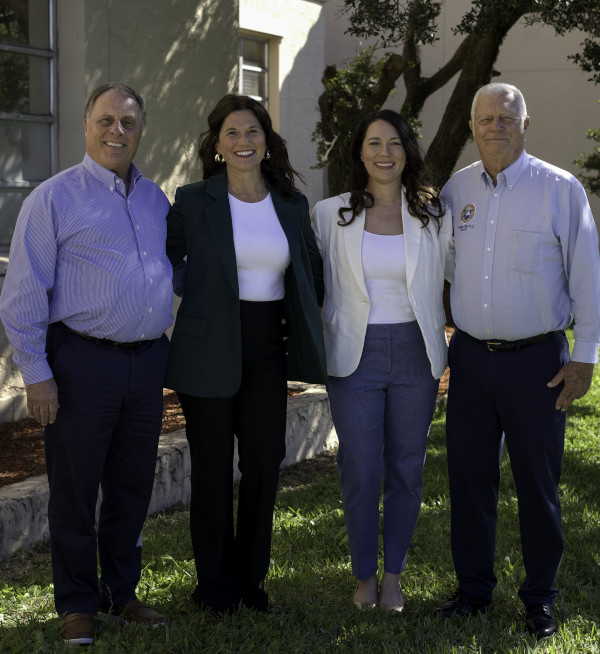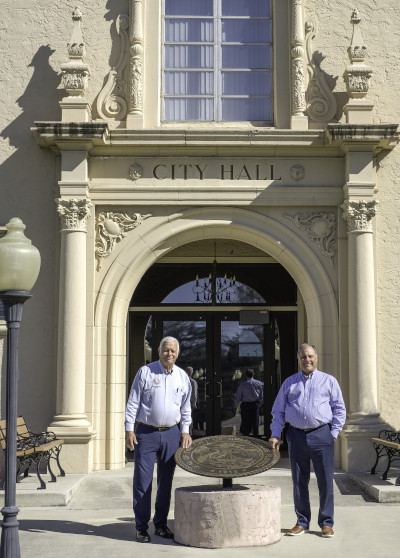City of Okeechobee, Florida
Growth and Connectivity in the Heart of Florida
Steering its future with strategic developments in infrastructure, business, and tourism while fostering a vibrant community and a thriving economic landscape.
Okeechobee, Florida, is a quaint yet vibrant community, encapsulating the essence of rural charm with a progressive tilt toward commercial and industrial growth. At the heart of Okeechobee County, the City of Okeechobee, with an area of just two square miles, is home to approximately 5,500 residents, serving as the commercial nucleus for a county population exceeding 40,000. Established in 1915, this City prides itself on a rich agricultural heritage, a foundational pillar deeply ingrained in the community’s identity and celebrated throughout the century.
Gary Ritter, the City Administrator, paints a vivid picture of a community at a crossroads, honoring its past while navigating the path of growth and modernization. Ritter articulates the city’s transformation, highlighting the influx of new businesses and commercial interests that have taken root in response to a gradually expanding population. Despite nearing its capacity in terms of development space, the city is ingeniously balancing growth with green space preservation, mainly through its parks.
Okeechobee’s downtown district is a focal point of community pride and revitalization efforts. With six parks undergoing development and rehabilitation, the city is preserving its green spaces and creating destinations that celebrate its agricultural roots. The newly completed Cattlemen’s Square, featuring life-size bronze statues depicting a cattle drive, offers a tangible connection to Okeechobee’s agricultural legacy and a magnet for residents and visitors, anchoring the downtown corridor.
Energizing Okeechobee’s Business Landscape
In the heart of Okeechobee, a dynamic interplay between tradition and modernity defines the local business ecosystem, with existing enterprises forming the backbone of this thriving community. Kaylee King, President of the Okeechobee County Economic Development Corporation, sheds light on the concerted efforts to nurture and expand the commercial fabric of the city.
“They’re critical,” she asserts, acknowledging the symbiotic relationship between the city’s economic health and commercial corridor. The collaboration between the Economic Development Corporation and the local Chamber of Commerce has been pivotal, focusing on the sustenance and growth of these enterprises. This partnership has given birth to the Business Retention and Expansion program, a strategic initiative to equip local businesses with the necessary resources and tools for growth.
“Our key performance indicators don’t just count new businesses. We measure success by the health and resources available to our existing businesses,” King explains. This nuanced approach to economic development, spearheaded by Alex Tijerina, Director of Existing Industry, underscores a commitment to nurturing the city’s commercial core while embracing expansion opportunities.
Getting into specifics, King names several large businesses and projects that exemplify Okeechobee’s industrial and commercial growth. Florida Power and Light’s hydrogen pilot project, NexAir LLC’s significant presence in the manufacturing and distributing of medical-grade oxygen, and Westlake Royal Roofing Solutions’ $15 million expansion project reflect the city’s capacity to attract and support significant enterprises. Additionally, the anticipation surrounding the final stages of the Bass Pro Lodge project illustrates the city’s appeal to large-scale tourism and retail ventures.

Infrastructure Initiatives in Okeechobee
The backbone of any thriving community lies in its infrastructure. From roads that connect people and places to water and sewer systems that underpin public health and development, Okeechobee is no exception. City administrator Ritter starts with internal roadways, acknowledging their essential role in the city’s day-to-day functionality and long-term development plans.
“Our council’s main concern is our internal roads,” he shares, underscoring the urgency of upgrading the infrastructure to keep pace with the city’s expansion. He notes the involvement of the Florida Department of Transportation (FDOT) in enhancing the major routes into the city, including significant improvements on Highway 70 and Highway 441. These efforts by FDOT are crucial, yet Ritter points out the ongoing challenge of securing sufficient funding for internal road maintenance and improvements, a task complicated by the anticipated increase in road usage as a result of population growth inside and outside the city.
Water and sewer infrastructure receives equal attention in Ritter’s commentary, as he highlights the complexities of managing these essential services within a growing community. The unique organizational structure of Okeechobee, where the city is served by the Okeechobee Utility Authority—an entity separate from the city government—presents its challenges. This distinction necessitates a collaborative approach to expanding water and sewer services to accommodate new developments within the city limits and in the surrounding county areas.
Bridging the Digital Divide
In an era where connectivity is as crucial as electricity and water, the push for widespread broadband access has become a pivotal agenda in communities nationwide. Okeechobee’s journey toward digital inclusivity, particularly during the COVID-19 pandemic, underscores a concerted effort to address the digital divide, ensuring every resident can access high-speed internet.
King reflects on the heightened awareness of broadband’s critical role in rural communities; a realization brought to the forefront during the pandemic’s peak. “We didn’t realize how important broadband was to a rural community until COVID,” she states, recounting the swift actions local authorities took to bridge the gap. Initiatives such as installing Wi-Fi in parks and distributing laptops and hotspots provided a temporary solution, but the vision for Okeechobee extended beyond immediate fixes.
King praises County Commissioner Terry Burrows, whom she dubs “the champion of broadband,” for his pivotal role in this initiative. Under his guidance, the technical committee has successfully identified two critical areas for immediate broadband expansion, with Comcast slated as the provider of choice. This targeted approach signifies a leap forward in making high-speed internet accessible and represents a broader commitment to ensuring that Okeechobee’s residents and businesses are not left behind in the digital era.
Residential and Community Development
As Okeechobee braces for an era of significant growth, the spotlight turns to residential development and the broader implications for community services. King envisions a city that embraces modern, mixed-use development, enhancing its walkability and livability. “The city holds so much of the commercial corridor, giving them these forward-thinking development opportunities,” she states, highlighting the appeal of such a setup for residents who value proximity to Main Street and Flagler Parks.
Devon Springs, a standout project mentioned by King, promises to be a mixed-use development that could serve as a self-contained community within Okeechobee, reminiscent of larger planned communities on the Treasure Coast. With a planned one million square feet of commercial space, Devon Springs represents a significant leap toward diversifying Okeechobee’s residential and retail offerings.
Education is also vital to sustainable growth, with King revealing plans for the construction of a new high school which was heralded as the largest project of its kind for a rural community in Florida, signaling a significant investment in the future of Okeechobee’s youth.
Construction for the new 250,000 square foot high school began earlier this spring and is expected to be completed within the next 2 to 3 years and will replace the existing high school facility. The new facility will include an upgraded CTE wing with plans to expand into new programs offered to students, including Outdoor Marine Technology, Artificial Intelligence, Criminal Justice Operations, Principles of Teaching, Entrepreneurship program and Principles of Agri-Business and Management. The new Okeechobee High School is projected to be $82.4 million dollars of capital investment.
 Ken Kenworthy, the Okeechobee County Schools Superintendent noted, “This is the largest capital project ever funded by the Small District Special Facilities Construction Program, administered by Florida Department of Education.”
Ken Kenworthy, the Okeechobee County Schools Superintendent noted, “This is the largest capital project ever funded by the Small District Special Facilities Construction Program, administered by Florida Department of Education.”
King adds an optimistic outlook on solving the housing inventory issue through the diversity of the projects underway. This diversity is crucial for meeting current needs and attracting professionals essential for the community’s growth, such as doctors, teachers, and other vital service providers. “Housing options are diversified,” King reflects, acknowledging the need to cater to a broad spectrum of residents to foster a balanced and thriving community.
Strengthening Local Business
In the evolving economic landscape of Okeechobee, the focus on supporting existing businesses has become a priority, marking a shift towards ensuring the longevity and expansion of the community’s commercial backbone. Alex Tijerina, Director of Existing Industry at the Okeechobee County Economic Development Corporation, introduces the Business Retention and Expansion Program, (BREP), an innovative approach designed to bolster the growth and success of local businesses within target industries.
“We’ve had a few businesses that looked to expand in size and were hitting walls,” Tijerina explains, detailing the program’s genesis. Acting as a bridge between businesses and regulatory departments, the VRA program (BREP) has facilitated the approval processes and ensured that expansion projects come to fruition.
Collaboration is at the heart of the VRA’s BREP’s success. By partnering with the local chamber of commerce, the program leverages a broad support network, targeting Okeechobee’s retail and service sectors and critical industries. “The ladies in the office are heading up the VRA efforts with the smaller businesses,” Tijerina notes, highlighting the synergy between different segments of the local economy.
The ultimate goal of the VRA program BRE Program is not just to support business expansion but to foster an environment where all industries in Okeechobee are aware of and can access the resources available to them. This initiative recognizes that many businesses, consumed by day-to-day operations, may lack the bandwidth to seek support independently. “Finding time to meet with them one on one and learning their needs and helping them meet those needs is going to be important,” Tijerina asserts, pinpointing the program’s commitment to personalized, hands-on assistance.
Okeechobee’s Forward Momentum
As Okeechobee strides into 2024, the city’s agenda is marked by strategic priorities that blend infrastructural development with enhancing tourist attractions, illustrating a comprehensive approach towards fostering economic growth and community well-being. Ritter outlines the city’s critical initiatives for the year, revealing a concerted effort to leverage Okeechobee’s natural and cultural assets alongside essential project infrastructure.
From the perspective of tourism, a notable project is the construction of a kayak ramp at a park off Taylor Creek, which flows into Lake Okeechobee. This initiative taps into the growing popularity of kayaking in the area, promising to attract outdoor enthusiasts and bolster local tourism. “Kayaking has become very popular in this area,” Ritter states, emphasizing the project’s alignment with the city’s goal to enhance recreational offerings and draw visitors to its natural landscapes.
Ritter also highlights the city’s commitment to facilitating business growth on the economic development front, exemplified by the swift permitting process for Westlake Royal Roofing’s upcoming construction. This project and the arrival of a significant Culver’s restaurant in a 16-acre commercial tract underscores Okeechobee’s appeal to businesses and its readiness to support its expansion efforts. “One of the things that we pride ourselves on in the city is being able to get these folks through the permitting process,” he notes, showcasing the city’s proactive stance in encouraging economic activity.
Furthermore, Ritter touches on a significant historical preservation and infrastructure project: rehabilitating the city hall building, constructed in 1926. With an approximately $1.8 million allocation, the project aims to harden and refurbish this century-old landmark, ensuring its resilience and continued service to the community. “It’s going to be 100 years old in two years,” Ritter remarks, highlighting the project’s contribution to preserving Okeechobee’s heritage while modernizing its facilities. Likewise, the City’s Mayor, Dowling Watford, shares his compassion for the history of the community and champions efforts to restore our cultural resources throughout the city. He is an active member of the Historical Society and a reenactor in the annual reenactment of the Battle of Okeechobee between Zachary Taylor and the Seminole Indians which took place on Christmas day in 1837,
As Okeechobee embarks on these ambitious projects in 2024, the city’s priorities reflect a multifaceted approach to development, balancing economic initiatives with enhancements to tourism and community assets. Through these efforts, Okeechobee aims to strengthen its infrastructure and financial base and enrich its residents’ lives and visitors’ experience, paving the way for a prosperous and vibrant future.
AT A GLANCE
City of Okeechobee
What: A small, vibrant city known for its rich agricultural heritage, strategic economic development, and burgeoning tourism sector.
Where: Okeechobee, Florida
Website: https://www.cityofokeechobee.com/






